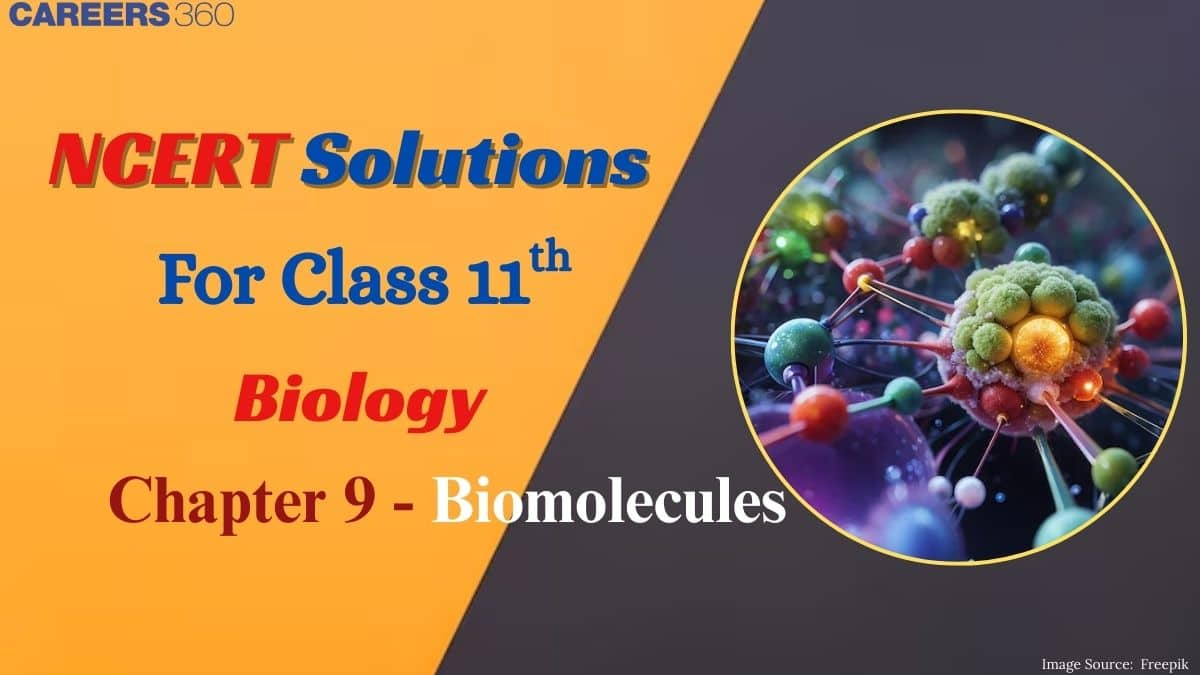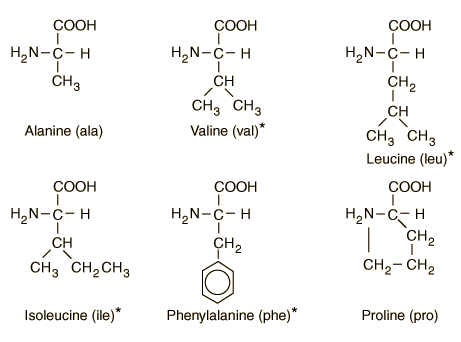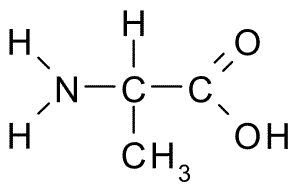NCERT Solutions For Class 11 Biology Chapter 9 - Biomolecules
The NCERT Solutions for Class 11 Biology Chapter 9 - Biomolecules explore complex biological compounds. It includes compounds such as carbohydrates, proteins, lipids, and nucleic acids. Biomolecules play an important role in various processes such as growth, development, and metabolism. With the help of the solutions, students can strengthen their understanding and identify the weak areas and work on them. The NCERT Solutions build a solid foundation in the subject of biology.
This Story also Contains
- Download Biomolecules NCERT Solutions PDF
- Get the Class 11 Biology Chapter 9 - Biomolecules Solutions (Exercise Questions)
- Approach to Solve Biomolecules Class 11 Question Answer
- Important Question of NCERT Class 11 Biology Chapter 9 Biomolecules
- What Students Learn from Biomolecules NCERT Solutions
- What Extra Should Students Study Beyond the NCERT for NEET?
- Chapter-Wise NCERT Solutions for Class 11 Biology

Biomolecules class 11 question answers are written in simple and easy-to-understand language by subject experts, which helps learners improve their conceptual clarity. The solutions explain complex topics step by step, making it easier to understand the structure and functions of different biomolecules. Regular practice with the NCERT Solutions for Class 11 improves problem-solving ability and builds confidence to score well in school exams and competitive exams like NEET.
Download Biomolecules NCERT Solutions PDF
The PDF for the chapter Biomolecules can be downloaded from the link given below. The Class 11 Biology Chapter 9 - Biomolecules question answer PDF can be used offline anytime for quick revision or homework help. This makes it easier to understand complex topics like carbohydrates, proteins, and enzymes.
Also Read,
Get the Class 11 Biology Chapter 9 - Biomolecules Solutions (Exercise Questions)
The detailed solved explanations of all the questions given in the textbook are given below. Each question is answered step by step and follows the NCERT guidelines closely. Studying through the Class 11 Biology Chapter 9 - Biomolecules question answer allows students to understand the structure clearly.
Q1. What are macromolecules? Give examples.
Answer:
The complex high molecular weight molecules separated in acid-insoluble fractions in the presence of trichloroacetic acid are referred to as macromolecules. They are polymers of a molecular weight of 10,000 daltons and above. Proteins, carbohydrates, nucleic acids, etc., are macromolecules. There are lipids in the acid-insoluble fraction, too, but they are not of high molecular weight.
Q2. What is meant by the tertiary structure of proteins?
Answer:
The three-dimensional configuration of a protein that arises from repeated coiling and folding of helical and pleated polypeptide chains is termed its tertiary structure. Through repeated folding and coiling, polar side chains remain exposed, whereas nonpolar amino acids are kept inside. The tertiary structure is bonded through weak bonds. The activity of a protein exists in tertiary structures.
Answer:
The structures of 10 small molecular-weight biomolecules are as follows.


These biomolecules are manufactured in biotechnology industries.
Answer:
Proteins with therapeutic uses are insulin, oxytocin, ADH, thrombin, fibrinogen, renin, immunoglobulin, diastase, streptokinase, etc.
Other applications of proteins are
1. As cosmetics- Proteins such as casein are used in beauty creams, shampoos, etc.
2. Sweeteners- Thaumatin and monellin are sweet proteins.
3. Dietary supplements- Proteins can be used as dietary supplements.
Q5. Explain the composition of triglycerides.
Answer:

A triglyceride is a chemical formed by the esterification of three molecules of fatty acids with one molecule of trihydric alcohol called glycerol. All three fatty acids of triglyceride can be similar, as in tripalmitin, or dissimilar, as in palmito-oleoistearin, dipalmitostearin, etc.

Answer:
Yes, we can try constructing models of biomolecules with the help of commercially purchased atomic models, like ball and stick models. The stick is, in the model, taken to be a bond, and balls of varying colours are taken to be atoms.
Answer:
The structure of the amino acid alanine is represented below:

Q8. What are gums made of? Is Fevicol different?
Answer:
Gums are made up of polysaccharides and pectins. These are the breakdown products of plant cell walls that are discharged from the wounds in the bark. Fevicol, on the other hand, is made of a sticky substance called resin. It is made of polyvinyl acetate. Gums are soluble in water, whereas resins are insoluble in water.
Answer:
One of the qualitative tests for proteins is the xanthoproteic test. When a qualitative test for protein in urine is done using the aid of the xanthoproteic test, if a yellow precipitate is formed, then it is guaranteed that there is protein in it. The qualitative test for fats is the emulsification test.
During the emulsification test, the experimental material is first treated with ethanol and then dissolved in water. The development of an emulsion proves the existence of fats. The qualitative analysis for oils is the translucent spot test. The material to be tested is placed on paper. The presence of oil is established when oil marks remain.
Answer:
Paper consists of wood pulp, which is predominantly composed of cellulose. Cellulose is a polymer of glucose molecules. Approximately 85 billion tonnes of cellulose are generated every year in the biosphere. Paper production requires 0.5 billion tonnes of wood. The rise in the usage of wood has caused immense loss of vegetation.
Q11. Describe the important properties of enzymes.
Answer:
Enzymes are proteinaceous substances that are capable of catalyzing chemical reactions of biological origin without themselves undergoing any change. They are commonly called biocatalysts. The properties of enzymes are as follows:
1. Enzymes are proteins by nature
2. Optimum temperature- An enzyme is active within a narrow range of temperature. The temperature at which an enzyme is most active is called the optimum temperature. The enzyme activity decreased above and below this temperature.
3. Optimum pH- Every enzyme has an optimum pH at which it is maximally active. Most of the intracellular enzymes work at neutral pH.
4. Enzymes are substrate specific, i.e., one enzyme catalyses only a particular substrate. Every enzyme has specific sites called active sites for the binding of substrate.
5. Only a small quantity of the enzyme is capable of forming the desired product
6. Enzyme activity is sensitive to certain chemicals called inhibitors or modulators.
Check the NCERT Books and NCERT Syllabus here:
Approach to Solve Biomolecules Class 11 Question Answer
To answer Biomolecules questions effectively, students can follow the simple steps given below:
Study the formation of chemicals in living organisms, for example, carbon, hydrogen, and oxygen.
Understand biomacromolecules such as proteins, nucleic acids, and polysaccharides. All the concepts are well-explained in the Class 11 Biology Chapter 9 - Biomolecules question answer.
Learn concepts such as the formation of an enzyme, its function, and the determinants of enzyme activity.
Note down primary and secondary metabolites and their role in metabolism. Make a comparison table using the Class 11 Biology Chapter 9 - Biomolecules Solutions.
- Practice questions given in the NCERT Solutions for Class 11 Biology to understand the biochemical reactions.
NCERT Solutions for Class 11: Subject-wise
Important Question of NCERT Class 11 Biology Chapter 9 Biomolecules
This chapter explains the structure and functions of biomolecules like carbohydrates, proteins, and nucleic acids. Given below is a question from this chapter, along with the answer. To score well, it is important to practice the questions given in the NCERT Solutions for Class 11 Biology Chapter 9 - Biomolecules.
Question: What type of bond joins monosaccharides in polysaccharides?
a. Peptide bond
b. Glycosidic bond
c. Phosphodiester bond
d. Hydrogen bond
Answer: The correct answer is option (b), Glycosidic bond
Explanation: Glycosidic bonds are the chemical connections between monosaccharide units in polysaccharides. Peptide bonds connect amino acids in proteins, phosphodiester bonds connect nucleotides in DNA and RNA, and hydrogen bonds are weaker interactions that stabilise the structure of molecules.
What Students Learn from Biomolecules NCERT Solutions
Living organisms are made up of different chemical compounds that play important functions. This chapter helps students explore some of the interesting facts about these compounds.
Students learn about carbohydrates, proteins, lipids, and nucleic acids, along with their structure and functions.
The Biomolecules NCERT Solutions explain concepts like enzymes, their properties, and the factors affecting enzyme activity.
Learners understand the methods used to analyse the chemical composition of living tissues.
The Biomolecules class 11 question answer, introduces metabolism and how different biomolecules participate in metabolic pathways.
What Extra Should Students Study Beyond the NCERT for NEET?
Here is a table for all the topics from the chapter, which students have to study beyond the NCERT for NEET. Students can also go through the NCERT Solutions for Class 11 Biology Chapter 9 - Biomolecules to gain clarity.
Chapter-Wise NCERT Solutions for Class 11 Biology
Below are the chapter-wise solutions:
Frequently Asked Questions (FAQs)
The different types of structures of biomacromolecules given in the NCERT Solutions for Class 11 Biology Chapter 9 Biomolecules are:
- Primary
- Secondary
- Tertiary
- Quaternary
The properties of enzymes covered in the NCERT Solutions for Class 11 Biology Chapter 9 Biomolecules are:
- The enzymes are complex macromolecules with a higher molecular weight.
- The enzymes help break down larger molecules into simpler molecules by catalyzing the biochemical reactions occurring within the cell.
- Enzymes are action-specific.
- At a pH level between 6 and 8, enzyme activity peaks.
The important topics of NCERT Solutions for Class 11 Biology Chapter 9 Biomolecules are:
- Primary and Secondary Metabolites
- Biomacromolecules
- Proteins
- Polysaccharides
- Nucleic Acids
- Structure of Proteins
- Nature of Bond Linking Monomers in a Polymer
- Metabolic Basis for Living
- The Living State
- Enzymes
Vitamins serve as coenzymes or coenzyme precursors, facilitating enzymatic reactions during metabolism. Vitamins assist in energy production, immune function, cell growth, and repair. Vitamins are either water-soluble (B-complex, C) or fat-soluble (A, D, E, K), with each having a unique biochemical function.
Nucleic acids (DNA and RNA) are nucleotide polymers, composed of a sugar, phosphate group, and nitrogenous base (A, T/U, G, C). DNA is double-helix, whereas RNA is typically single-stranded. They carry and transfer genetic information, with DNA coordinating protein synthesis and RNA helping in transcription and translation. Their structure allows replication, gene expression, and heredity in living things.
Popular Questions
Courses After 12th
Applications for Admissions are open.
This ebook serves as a valuable study guide for NEET 2025 exam.
NEET Previous 10 Year Questions
Get nowThis e-book offers NEET PYQ and serves as an indispensable NEET study material.
JEE Main Important Physics formulas
Get nowAs per latest syllabus. Physics formulas, equations, & laws of class 11 & 12th chapters
JEE Main Important Chemistry formulas
Get nowAs per latest syllabus. Chemistry formulas, equations, & laws of class 11 & 12th chapters
JEE Main high scoring chapters and topics
Get nowAs per latest 2024 syllabus. Study 40% syllabus and score upto 100% marks in JEE
JEE Main Important Mathematics Formulas
Get nowAs per latest syllabus. Maths formulas, equations, & theorems of class 11 & 12th chapters
